Sponsored By
ROCK
HARDWARE
 Interview: Malcolm Matheson (aka "HB")
Interview: Malcolm Matheson (aka "HB")[ More Interviews | Video ]
Date:
August 2003
Intro: The name Malcolm Matheson conjures an image of incredible
strength and style owing to an impressive tick list of hard, ground up,
often trad ascents in an era when the top end of the grades are
increasingly the dominion of sport climbers leading on pre-placed gear.
Malcolm began climbing in 1978 as a Horsham local lad. He put up the ever
attractive Angular Perspective (27) at Bundaleer in the Grampians 1983,
returning later in 86 to extend the route (28) through the roof. 1987 saw
his ground up, FA of "Journey Through Nicaragua" (30) at Mt Stapylton and
a year later he became the master of Taipan Wall with the FA of Serpentine
(31), also in true ground up style, a route which was at the time
considered the hardest ever climbed by an Australian and is these days
rarely repeated without rap inspection and pre-placed crux gear. 1989/90
saw Malcolm putting up Contra Arms Pump (30), Red October (30) and the
ever impressive Mirage (27) on Taipan Wall with it's dyno crux made famous
by Simon Carter's photography. 1990 was also a big year for Malcolm with a
return to the USA where he did such things as the Salathe Wall, 35 pitches
in 2 days and the Nose of El Capitan in Yosemite in 2 and a half days, as
well as repeating several other hard routes. In the Grampians, at the ever
popular Gallery Malcolm has pretty much swept the table with FAs of Monkey
Puzzle (28), Chasin' The Shadow (27), Gorrilla Tactics (26), and Hueco
Dreaming (25) and a repeat of Like A Koala in its Eucalyptus (30). In 1993
his FA of Welcome To Barbados (29/30), a 50m trad roof at Red Cave in the
Grampians, that sees the climber upside down for most of the way, was done
ground up, clean on his second attempt. The Great Shark Hunt (30) at Mt
Buffalo and regarded as Victoria's hardest crack climb is also another of
Malcolm's creations done in ground up style. Buffalo has held an
attraction for Malcolm for sometime with a 3 and a half hour ascent of
Ozymandias Direct (255m) in 1997 and several roped solos over the years.
Malcolm is also known for making his own gear, producing much prized micro
cams in the 1980's at a time when Wild Country (the maker's of "Friends"),
said smaller sizes were not possible. Excelling on steep overhanging
terrain and hard crack routes, Malcolm, now a proud father is still
climbing with the best of them today. He counts his hardest ascents as his
FA Demon Flower (31) and his repeat of Gilgamesh (31 M0).
| Notable First Ascents | ||||||||||||||||||||||||||||||||||||||||||||
|
[ Deep in the Grampiansí Victoria Range on a cold winterís
eve in August 2003, the campfire crackles lazily, providing much needed
heat to a small band of climbers tired from the days ascents. With the
remains of dinner cleared away everyone is kicking back enjoying the
warmth.]
Chockstone: Ok, so where did it all
begin? Can you recall your first experiences with climbing?
HB: It began in 1978 in a quarry south of Horsham and unbeknown to my
parents Iíd go to the quarry to do some abseiling with a piece of
polypropylene rope I got from the hardware store and some home made
carabiners. [laughs]. That was sometime in 1978. I guess I got interested
in climbing by reading about it. Basically looking at climbing in books,
mountaineering mostly, and that led to doing a bit of reading about
rock-climbing and so forth. So thatís initially where my interest came
from. At some point my parents discovered the equipment I had made and
asked what was going on, and they thought theyíd better get me to some
real climbers before I hurt myself. [laughs].
Others: So they introduced you to some
real climbers?
HB: Yeah, they drove me out to Arapiles and asked around for someone to
take me climbing. And I remember the first route I did at Arapiles was
Eagle Cleft (11) followed by Block Buster (10) which was quite a big route
to do as a first route.
Chockstone: Thatís up on Tiger Wall?
HB: Yeah, yeahÖ.
Others: Who took you up?
HB: If my memory serves me correctly it may have been Peter Watson and
someone else who I canít remember. That would have been in November Ď78.
Chockstone: Your approach to climbing in
the early years involved a methodical progression through the grades,
moving from one grade to the next, has this been profitable?
HB: That was just the approach I took at the time and it may have itís
good points and bad points. I think what I tended to do is to try and
become consistent at itÖ at a particular grade. So Iíd try a few routes at
a particular grade, say, 21, of a few different styles, so that I became
quite confident at that grade. I guess Iíd occasionally try harder things,
but generally Iíd try to consolidate my climbing at the level I was
climbing at the time, and once I felt like I was managing that pretty
comfortably, Iíd try some harder routes. But by the same token, I wouldnít
spend a year on one grade. Iíd maybe do ten routes of a grade before
trying the next grade upÖ something like that.
Chockstone: You made a lot of your own
gear in the eighties Ė where did that arise from?
HB: Initially the first bit of gear I made was a halfsize friend which
wasnít available commercially. I canít remember exactly what inspired me
to make one but I think maybe just talking about one around the campfireÖ
ďWouldnít it be great to have a friend that would fit into finger
cracks?Ē. And I thought, it must be possible, so I made one. That was
sometime in late Ď81, I think.
Chockstone: I think I read somewhere
that Wild Country said it wasnít possible, and you were doing the
impossible.
HB: [laughs] Iím not too sure about that, but yeah, and Kim Carrigan
offered to buy it off me for quite a large sum of money. [laughs].
Others: So you took him up on the deal?
HB: No I think I wanted to hold onto it actually and I wound up using it
quite a bit myself.
Others: You still got it today?
HB: I donít know if I have that one, but I do have three or four of the
cams that I did make later on because I wound up making about a thousand
of them.
Others: Wow, geez!
Chockstone: How long did they take to make? To make a cam?
HB: Well in the end, when I started mass producing them, I was making
batches of over three hundred and I think I was spending around 350 hours
for a batch. I was doing okay because there was a bit of cost in it. I was
using titanium for the shafts and 606126 aircraft aluminium for the cams.
And thatís quite expensive. I made okay money out of it. It financed two
trips to the states in 84/85.
Others: Howíd you manufacture the cam
heads? Did you, like, build them, orÖ?
HB: I actually built a gig and I made a manipulative arm that held a
router and used a gang of cam profiles to run the router blade around, and
that would cut the cams into the shape. The cams would be cut into
rectangles and bolted to the top of the profiles and the router cutter had
a bearing on the end which would follow the profile and cut the cams into
the right shape.
Others: Sweet!
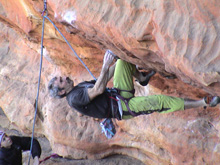
|
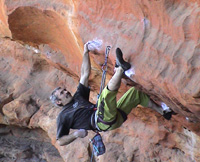 |
Above: Malcolm Matheson on Poison Bait (25) at
Scoop Rocks in the Grampians.
Photos By Michael Boniwell.
Chockstone: Okay, you established all
sorts of sports climbs, trad climbs, steep stuff, slabby stuffÖ is there
anything you specialise in? Do you have a particular style that youíre
good at? Or a weakness?
HB: Arh, I think I definitely have weaknesses. Iím not overly good at
vertical face. I mean I can climb it, but Iím not as good at vertical face
as I am at some other styles. On granite I think I do pretty well on under
vertical, like stabs and steep face, what Iíd call steep slabs. But I
guess my strongest style is severely overhanging rock. [laughs]. It also
happens to be my favourite style of climbing. In saying that, Iíve found
that Buffalo has been exceptionally good for my climbing in terms of
balancing my climbing. I see it as balancing out the differences in
styles. I think if you become too focused on just super steep stuff then
you can really lack a lot of subtleties in climbing that you would get
from climbing under vertical thin stuff in terms of being really in tune
with your footwork and body movement.
Basically Iíve spent my summers, or a good part of the summer at Buffalo
when itís too hot to climb in the Grampians, working on that type of
climbing, where itís very technique based, not strength based. Very often
head based, in other words, youíre climbing very ultra thin stuff where
youíre almost off all the time, well above bolts. I see it as good head
training as well. Often Iíve found that Iíll come back from climbing at
Buffalo for a season and just be really positive in my mind for climbing
on steep stuff, because youíll clip a bolt or get some good gear in, and
youíll feel comfortable running it out, knowing that itís steep and youíre
not going to get gravel rash going down the granite. [laughs].
Others: You did a lot of slab at
Yosemite?
HB: I never did much slab in Yosemite, no. Whenever Iíve gone to the
States Iíve primarily focused on crack climbing, which is another
favourite aspect of my climbing. Because we donít have that many good
cracks in Australia I really like to spend a fair bit of time on cracks in
the States.
Others: So would you call yourself a
strong crack climber as well?
HB: Reasonably. Yeah. Maybe not quite as good as my stronger style, but
yeah, pretty good I think. Iíve done a couple of the hardest cracks in the
States.
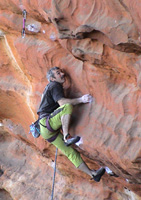 |
 |
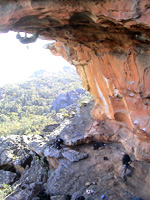 |
Above: Malcolm Matheson on Poison Bait (25) at
Scoop Rocks in the Grampians.
Photos By Michael Boniwell.
Chockstone: Youíre noted for leading
routes in good style. Ground up with no pre-placed gear. Some of your
hardest first ascents, including Serpentine (31) are rarely repeated in
such good style, usually being rap inspected and having pre-placed gear on
the crux. Does this disappoint you that people arenít repeating it in the
same style that you led it?
HB: Yeah, to some extent. I mean I think this is a personal opinion thing
butÖ obviously climbing styles have changed a lot over the years,
especially with the advent of sport climbing. Basically when I did
Serpentine, sport climbing was only just beginning to emerge, and when I
started climbing it was considered seriously unethical to place a piece of
gear while sitting on the rope or on an abseil rope. You know, it was just
simply not a clean ascent at all. So I grew up with this ethic and I still
prefer to do routes in that style. I think the reason I find it valid, at
least for myself, is itís more or less the same as just being able to walk
up to a route and just do it, rather than having it all pre-prepared for
you. Even if youíve worked on it.
I have tended to use this style which I call ďgear in, in a dayĒ. So if I
try a route, and it takes me several tries, it doesnít mean that after
each try, after Iíve fallen off, Iím going to rap down and pull all the
gear out, so that I can put it back in the next try, but it means Iíll
leave the gear in for that day. If donít happen to get up it that day,
then Iíll rap and clean it at the end of the day, and next time I come
back to it Iíll put the gear in again. Because I see that putting the gear
in, especially on a trad route, is an extremely valid part of the ascent
in terms of it takes energy to put it in, in the same way that it takes
energy to work out the moves and climb it. But if youíve put the gear in
on one day, then gone away and had three days rest, and come back and itís
still in, even if you put it in free, the effort of putting it in, on that
particular day, three days ago, is no longer valid Ė it might as well have
been rapped in. That effort of getting it in no longer counts for that
particular day. So thatís where Iíve used this ďgear in, in a dayĒ ethic,
and thatís just a personal ethic Iíve used and it partly developed from
climbing in the States where if you tried a route and you didnít get up it
that day you couldnít afford to leave it in because you come back and it
wouldnít be there. [laughs]. So you had to pull the gear out.
Certainly in the early days of climbing at Arapiles, my climbing style was
the style of the day, which was ďyo-yoĒ style. Youíd go up a climb and
fall off, youíd sit on the rope, work the moves that you fell off, then
lower down, and usually leave the rope in place. So essentially the rope
is clipped up to the highest piece of gear, placed free. So even if you
were dogging the move off the highest point placed free, you werenít
allowed to then go on and put another piece in because youíd sat on the
rope. And so this is how the ďyo-yoĒ style went. But eventually I started
using the technique of pulling my rope between tries because I saw that as
quite a lot better ascent. Thatís what is very important in sport climbing
these days. That even if youíre trying a sport route you donít leave the
rope clipped up the highest bolt these days. The rope gets pulled at the
end of each shot, so essentially youíre leading it every time you go up on
it.
Chockstone: Itís been noted that you
climb with a great deal of confidence in your footworkÖ Umm, we already
covered that one I think. Working routes at Buffalo has increased your
footwork, would you say that?
HB: Oh definitely. Yeah. I wouldnít say just Buffalo. Climbing in the
States has as well, but yeah, I think primarily Buffalo. And the thing
about it too, I think climbing at Buffalo, and improving your footwork,
actually helps your footwork in all your climbing, not just low angle
granite. It improves my footwork on steep stuff as well.
Chockstone: Lets talk about Taipan Wall.
Youíre one of the co-founders of Taipan Wall. And I know youíre fairly
passionate about it. Can you talk about when it was being developed, the
other people involved, what went on?
HB: In my time or before hand?
Chockstone: In your time.
HB: Well I know Kim Carrigan had done some routes in the early to mid
eighties. I think up to 84 or something like that, but I hadnít any
involvement in that. I was around climbing at the time, but in those years
I was either climbing at Arapiles or occasionally in the States. I first
became interested in Taipan after climbing Journey Through Nicaragua (30)
at the Sandinista Cliffs. Looking across at that wall and thinking ďhmmm,
I wonder whatís over there?Ē. I distinctly remember this, rapping down a
line that looked quite good, and hanging on the abseil rope, and kept
looking across at the turret of Serpentine (31) and thinking ďthere are
more holds on that than what Iím rappingĒ. So I quickly rapped down, raced
around to the top, shifted my rope across, and started rapping down the
turret of Serpentine (31) Ė the upper head wall. It was the first route I
prepared and did on Taipan, actually. It was quite an amazing journey for
me in some respects, actually.
Others: I thought youíd done Serpentine
(31) before Sirocco (26) ?
HB: Oh yeah, I think I did Sirocco (26) in about 1990. So itís two years
later.
Others: Why did you say it was an
amazing journey?
HB: It was the hardest route Iíd ever tried at the time and when I first
rapped it I could see it had holds all over it, but I didnít know if I
could climb it, or whether I was good enough to climb it. Basically I
spent eight days trying it, and was having trouble at one particular spot
because my fingers wouldnít fit in this thin slot at the second crux. I
eventually did it, but I was also trying it in a more traditional way, I
wasnít trying it in a sport climbing style. If Iíd done that I would
probably have spent a lot less time on it. That way I was trying it, I was
climbing as far as I could, and then if I fell off Iíd work those moves,
then lower down and pull the rope and try it again. So it was more of a
traditional way that I tried that route. And even though I had actually
seen the top of it three months earlier when I first abseiled down it and
put the bolts in, I certainly didnít know what the moves were because I
donít like checking out moves on abseil. So when I finally got through
that second crux, I was so motivated that I managed to get to the top
without any more falls.
Others: Did you have a celebration after
youíd done it?
HB: I actually gave up climbing for ten months because I was pretty burnt
out at the time. Iíd been climbing a lot. I went down to Tasmania and
worked on a building project for ten months.
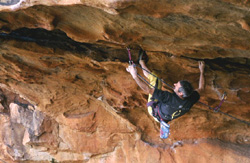 |
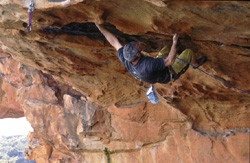 |
Right:
Malcolm Matheson on Poison Bait (25) at
Scoop Rocks in the Grampians.
Photos By Tim Le.
Chockstone: You didnít run up any of
Tassieís routes while you were there?
HB: No I didnít climb at all in Tassie. I actually spent eight months
weight training.
Chockstone: Did that help your climbing?
HB: I think so. I think it gave me a really good power base. I did quite a
lot of training when I was in Tasmania. No climbing whatsoever, but a lot
of training, and when I came back, I was dead strong. Didnít have much
endurance, but I remember this first route I ever did when I came back. It
was 26 - took me three tries, but I thought it was a pretty good route to
do after ten months off. [laughs]. I think I retained a fair bit of
strength from all that weight training and so forth.
Others: Youíd done weight training prior
to that though hadnít you?
HB: A little bit, not a lot. Ö.. I noticed in a previous sheet [of the
interview questions], that there was a mention of Serpentine (31) being a
controversial ascent? Thatís the first time Iíve ever heard it called
that. Controversial in what way?
Chockstone: Iím not sure. Someone else
put that question in. I didnít understand it, so I took it off.
HB: I was wondering what was controversial about it? Maybe the fact that
it was done with all the gear being placed on lead. Perhaps.
Chockstone: Thatís called controversial?
Itís almost the opposite. Itís outstanding.
HB: But I think a lot of people still donít, sort of believe thatÖ I mean
I donít think they seriously disbelieve, but I think they donít understand
doing something like that too much.
Chockstone: Ever thought about doing an
ascent of Punks In The Gym (31/32)?
HB: I thought about it, but not seriously. I had one short look at it, but
I didnít seriously try it for a couple of reasons. One being itís not
particularly my style. Iím sure if I spent enough time on it I could have
done it, but itís not the style Iím that fond of. Itís too close to
vertical and too thin. Secondly itís very modified. Especially the crux.
Itís got a couple of chipped holds on it, and itís been frigged around
with, itís been glued, and itís had bolts added, and bolted chopped, and
itís become quite a mess over the years in that respect. Itís also because
itís such an iconic route in a lot of respects that people were more or
less expecting me to do it, and I donít respond to that sort of peer
pressure. Iím not really interested for those reasons. Basically I climb
for myself, not because other people want me to try it or to do it.
I think because of all the debate about that route too. People were trying
or doing it with increasingly suspect ethics. I think by my standard of
ethics, which is not necessarily something I want to imply on others, but
I think thereís definitely been some suspicious stuff going on, on that
route. You know this rule, if you can climb up to the first bolt and clip
it and climb back down you can pretty much permanently leave it clipped?
Which I think has validity in some respects. I think if you can climb up
to a bolt and clip it and then climb back to the ground and have a bit of
a rest before you really try it thatís great, thatís fine, but I think
once youíve fallen off, that is cancelled. I donít think you should be
able to leave it clipped up there. Youíve weighted the rope Ė the rope
should be pulled.
It got to the point where people were leaving the first bolt clipped.
Theyíd rap in and clip the first bolt, not because theyíd climbed up and
clipped it and climbed back down, but because somebody else had! [laughs].
And then somebody else managed to climb back down from the second bolt, so
the rope got left up there! [laughs]. It was just quite absurd. The reason
this was happening was because the route starts up another route called
Punks In The Gunks and Punks In The Gunks is climbed on very thin wires,
itís quite insecure laybacking on really poor feet and the wires arenít
that good. So people found it scary. I can understand why they would
rather the first bolt clipped. It was just interesting that it seemed
valid for everyone who tried it to rap in and clip the first bolt just
because someone managed to climb down from it Ė once. These are some of
the things that used to go on. I just found it quite amusing. But yeah, I
never seriously tried the routeÖ I tried it once.
Chockstone: Thereís an old aid route
that you almost freed in the nineties called Gilgamesh at Mt Stapylton,
listed as grade 31 M0. Word has it you could do it with one rest at the
time and thought it was possibly one of the hardest routes in the world if
it had gone free. Have you ever gone back and had another go?
HB: No. Not recently, no. It was a bit of a nemesis, that route for me. I
came so close to doing it so many times. And yes I did it with one sit on
the rope, at least three times. I should have done it, but I didnít.
[laughs]. Not quite. Barely. Almost there, but not quite. In the end I
started going backwards on it because Iíd spent too much time on that
particular route and not enough time climbing in general. I was
progressively having less and less success on the route. Then I just
thought ďthis is stupidĒ and gave it up. I havenít touched it for ten
years. I think it was a pretty hard route. I used to go and try that route
for a couple of hours until I was powered out, then Iíd go over to ďDaniel
or TigerĒ (31) and throw three or four laps on it. So there was obviously
quite a significant difference in the difficulty.
Chockstone: Passport to Insanity (28) at
the Fortress in the Grampians was freed at a time you were active in the
area. Did you ever consider getting involved in the FFA?
HB: It was freed, I think, in 85 and I wasnít active in the area. I think
Iíd hardly done any climbing at all in the Grampians, to speak of. Still
in Ď85 Iíd been mostly climbing at Arapiles, and maybe just done a tiny
bit in the Grampians. But in 81, I think, Mark Morehead and Glenn Tempest
and myself went up and had a little bit of a foray into looking at the
possibility of freeing Passport. We all climbed up. We all stuck our hands
in the roof crack and all thought ďhmmm, this is pretty thin, this is
going to be pretty hardĒ. At the time I was only climbing about 24 and I
didnít think I could do it at that stage. None of us thought we had a
serious chance at being able to do it, so we bailed. We didnít seriously
try it. But certainly in 85 I probably would have been capable of doing by
that stage, but I wasnít climbing in the Grampians at all really.
Chockstone: Youíve recently ticked off
two new routes, which share the same first pitch, one which has a wild,
roof-like arÍte on the 2nd pitch. The routeís called ďA Space OdysseyĒ.
Can you tell us how you came to spot the line, and thought that it would
go?
HB: I first saw it when I did a route of Simon Mentzís, on the same piece
of rock about 15 metres to the right. I did that route with Steve Monks
last year and I looked across and I saw the overhanging headwall and
thought ďthat looks great, Iíll have to come back and have a look at
thatĒ. So I did. And it is great. Really, really excellent climbing. Took
a while to think of the name, but I think itís very appropriate because
itís pretty spacious up there.
Chockstone: I understand youíve got a
new little daughter. Yes, obviously because weíve seen her today!
[laughs]. First of all congratulations. Secondly I hear youíve already
named a route after a game of hers called ďAnticsĒ.
HB: Well not exactly a game of hers but a friend brought back some wooden play blocks from the States with ants printed all over them and if you stack the blocks in a certain pattern or direction you get a continuous line of ants up these blocks. The blocks were called ďAnticsĒ. I was also looking for a name to tie in with Neilís [Monteith] route right next door which is called ďArmy Of AntsĒ. So I thought that was quite good. Antics in the roof. Thatís where the name came from Ė a couple of ideas coming together.
Right: Malcolm Matheson during the first
ascent of his new roof climb "Antics" (26) at Sentinel Cave, Grampians.
(Photo By Neil Monteith).
Chockstone: Still on the topic of
family, are you finding a balance between family and climbing an easy
thing to accomplish?
HB: Oh, yes and no. Itís more a balance between family and work and
climbing rather, and a need to keep earning money to support a family. I
have to work a lot more than I used to. Yeah I do climb less, but when I
do climb I try to get some quality climbing time in. But yeah there are
compromises for sure.
Chockstone: Youíre still climbing hard,
obviously. Iíve heard you can cut three laps of Monkey Puzzle (28) at the
Gallery, or a single lap in your approach shoes. (I think it was Jac who
told me that).
HB: Yeah, well, I did it once in my approach shoes. Just for fun.
[laughs]. And I only ever did it once. Iíve actually wanted to do it in a
pair of Tevas but arhÖ[laughs]. Iíll have to see next summer if I get a
decent pair of Tevas. I think I could actually do it, but there is a bit
of footwork involved. I did have a pair of Tevas that had some Stealth C4
rubber on the bottom of them, and Iíve climbed routes at Buffalo in those.
[laughs]. Not hard ones, but up to about 21. I did Commander Cody (21) in
my Tevas. But yeah I thought it would be quite funny to do Money Puzzle
(28) in my Tevas. I think I could do that. But as far as doing laps on it
- I think could do three laps at the moment, but I have actually done 10
laps in day, in the past.
Chockstone: Are you still aiming for
hard grades? Like 31?
HB: Yeah, Iíd like too. I think I could if I had the time. As long as my
shoulder holds out (cause I injured my shoulder really badly about a year
and a half ago). It seems fine at the moment. I think I would need to do
some reasonably serious training and climbing to get back to that
standard. Maybe not. I feel like itís not too far away, but I think itís
partly dependant on whether my shoulder holds up.
Chockstone: What about getting back to
Buffalo and doing some, I suppose youíd call it Big Walling?
HB: Oh, yes and no. I think Iím a little bit burnt out by that now. I did
quite a bit of that over the years and at the moment I donít feel overly
motivated to do Big Walls at Buffalo too much anymore. Iíd be more
inclined to do big stuff on El Cap. Thereís still stuff I want to do on El
Cap. Depends on whether I get back to the States or not. I do have a lot
things I want to do at Buffalo, but theyíre mostly shorter free routes.
Chockstone: We did talk a bit about
training before, but if we can go more into it now. Youíve got a woodie at
home? And apparently you can do one arm locks on your little finger? Is
that true?
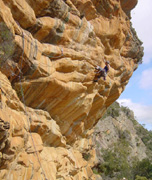 HB: Well I donít have a woodie at home, but I have access to quite a good
indoor home gym. A friend of mine owns it. Thatís got three walls on
various angles. I go in there occasionally and do a bit of work, but at
the moment I havenít been seriously training for a long time. Not since I
injured my shoulder. Also because Iíve been really busy with work and
stuff like that, and family. But I think I will gradually bring the
training back in again. As far as one finger lock offsÖ [laughs], I donít
think Iíve ever been able to do that on my little finger, but I have been
able to do one arm pull ups on my index finger, through a sling. I donít
know if I could right at the moment. [laughs]. I used to be able to do two
on the right hand and one on the left. But not on my little finger. You
might be thinking about Wolfgang Gulich there I think! [laughs]
HB: Well I donít have a woodie at home, but I have access to quite a good
indoor home gym. A friend of mine owns it. Thatís got three walls on
various angles. I go in there occasionally and do a bit of work, but at
the moment I havenít been seriously training for a long time. Not since I
injured my shoulder. Also because Iíve been really busy with work and
stuff like that, and family. But I think I will gradually bring the
training back in again. As far as one finger lock offsÖ [laughs], I donít
think Iíve ever been able to do that on my little finger, but I have been
able to do one arm pull ups on my index finger, through a sling. I donít
know if I could right at the moment. [laughs]. I used to be able to do two
on the right hand and one on the left. But not on my little finger. You
might be thinking about Wolfgang Gulich there I think! [laughs]
Right: Malcolm Matheson
does the trad traverse classic of Stone Temptress (22),
Centurion Walls,
Grampians. Photo By Neil Monteith.
Chockstone: Still on training, can you
think of any tips for young players?
HB: I think thereís so much information on training these days Iím not
sure I could particularly add to it.
Chockstone: Well, whatís worked for you?
HB: Oh, I think that training is good for helping to make you more robust
against injury. Apart from my shoulder I havenít had any injuries at all.
I never focused much on my legs, because my legs were pretty strong
anyway, and I didnít want to build too much muscle weight or mass in my
legs. But I think if youíve got skinny legs, doing some leg work is
important, especially if youíre going to be using your feet really well.
But I think generally in the upper body, I think just beefing everything
up a bit more so youíre more resilient against injury is really quite
beneficial in terms of holding your joints together.
Chockstone: So, the idea of working
opposing muscles you donít work when climbing?
HB: Yeah, exactly. I know a lot of people have problems with shoulders and
stuff, and I think that can be helped a lot by increasing general shoulder
strength and building a bit of mass around there to just keep everything
in place. I mean, this is a theory of mine, but I think that the weight
training has helped me in that respect and just given me a really good
power base. But by the same token you donít want to be building too much
muscle mass otherwise youíre just going to get too heavy.
Others: How have you avoided finger
injury all this time?
HB: I think itís partly hereditary. I naturally have thick fingers. And I
think, also, I didnít climb really hard straight away. I built up into it.
My body had quite a long time to adapt. I didnít climb harder than about
21 in the first year and by the second year I was only climbing about 23
or something, or 24. So it was quite a slow progression by todayís
standards. You get young kids out there who are, certainly on sport routes
or in the gym, climbing 24 within six weeks. Because I had quite a slow
progression that maybe it helped strengthen my body against injury. It
gave my tendons a chance to strengthen up and thicken. Youíre tendons will
get thicker and stronger, but because they have such a low blood supply,
it takes a long time.
Chockstone: What about diet? I know you
break out the can of tuna.
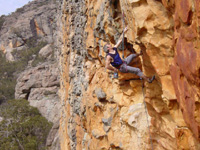
HB: I havenít been fanatical about diet over the years, but Iíve been
conscious about eating fairly well. I used to eat a lot of carbohydrate
which I think was great for when I was doing high volumes of climbing and
just for generally providing a lot of energy. But I think that these days
they reckon too much carbohydrate can get stored as fat, but I donít think
I suffer from that problem as yet [chuckles]. Generally I eat fairly low
fat foods. I donít eat too much red meat. I donít eat too much fatty food.
I try to eat a reasonable amount of vegetables.
Right: Malcolm Matheson
flashes Wired (22), Cut
Lunch Walls, Grampians. Photo By Neil Monteith.
More recently a friend of mine, from England, who is pretty fanatical
about diet, has made me aware that I probably should be eating a lot more
protein than I do, especially as I get older. He was basically saying that
an individual who is training and climbing hard, and working, should be
having at least one and half grams of protein per kg of body weight daily.
Which is around about 100 grams of protein daily for me and I know I donít
eat that much. Maybe that is a little over the top, but he certainly made
me aware that I should be eating more, because I wasnít actually eating
much meat at all. Iíd maybe only eat meat maybe once or twice a week.
Apparently itís most important straight after exercise. Within the first
20 minutes and definitely within one hour, to get the best benefits from
protein intake Ė which is why I often carry tins of tuna away to the crag
with me now. I think as I get older itís probably a lot more important
now. When I was younger it would be less so, I think. As you get older I
think youíve got to get a bit smarter as far as that sort of thing goes.
Chockstone: You mentioned the shoulder
injury. You also got an injury in Ď79 in regards to explosive chemicals
that almost took off your hand? What was the story with that?
HB: That was a bit early than Ď79 actually. I think it was when I was 15
or something. I basically had quite an extensive chemistry set and I used
to mix all sorts of things up. I started making touch sensitive
explosives. [laughs]. Which were great! You could make some explosive, put
it in a coffee jar and pitch it over the back fence, and itíd go with a
hell of a bang. One day it blew up in my face, and did quite a bit of
damage to my left hand.
Chockstone: Obviously hasnít impacted
your climbing though?
HB: NoÖ In some respects it has because these fingers [presents two
fingers], wonít straighten out. Like theyíll bend but they wonít
straighten out. In crack climbing it becomes a bit of an issue, especially
left facing corners. But generally it hasnít effected my climbing.
Chockstone: Have you ever been involved
in any serious epics?
HB: No. Not serious at all. I think probably the worst thing thatís ever
happened is having come down big routes in Yosemite in the dark without a
head torch. [laughs]. And thatís about it. Or being stormed off Astroman.
With a rap in the storm. Pissing rain. Getting drenched. Thatís about the
worst.
Chockstone: Thatís pretty good, given
the number of years youíve climbed.
HB: Iíve never had any sort of climbing accident.
Chockstone: Would you say thatís because
you think youíre cautious, or itís luck, orÖ?
HB: I think itís awareness. Iíve actually thought about this a bit. Iíve
come close a couple of times. I had somebody unclip me off belay once
without my knowledge, and I almost sat back on the rope again thinking I
was clipped in. Would have gone 30 metres to the ground if that had
happened. And I almost fell off the top of the great wall at Moonaire
because what I was standing on broke. But apart from that I havenít had
any close calls at all. I used to climb really cautiously. Really
conservatively when I was starting out. I think I developed a pretty good
awareness of what I was capable of, and what dangers exist.
Itís an interesting thing because thereís the clothing label you get out
these days, ďNo FearĒ. You see a lot of young guys trying to emulate that
sort of approach to climbing, and itís not necessarily that good because
its fear that keeps you safe. Its fear that makes you analyse potentially
risking situations. I see fear as having a very important role in climbing
because it makes you stop and think ďhey, is this actually dangerous or is
it just a perceived danger?Ē It makes you analyse situations. I think
because I do have an analytical mind, in a way, I assess things quite
well. I mean, yeah, I put myself at risk sometimes. It becomes what you
call ďcalculated riskĒ, and I think itís something climbers put into
action all the time. ďUncalculated riskĒ I think is the real problem.
People going head long into something without actually assessing the
potential risks. I think itís this approach thatís really helped me over
the years.
Others: Is it that you also consolidated
at the grade too?
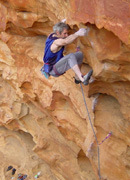 HB: Maybe. Yeah, I think in respects being solid at a grade can make you
safer at a grade, but it only makes you safer if you know youíre not going
to fall off. I mean if youíre climbing and falling off, then you really
have to know that your gear is good, or that the bolts are good, or the
belayer is not going to drop you.
HB: Maybe. Yeah, I think in respects being solid at a grade can make you
safer at a grade, but it only makes you safer if you know youíre not going
to fall off. I mean if youíre climbing and falling off, then you really
have to know that your gear is good, or that the bolts are good, or the
belayer is not going to drop you.
A guy at Frog Buttress approached me a few years ago. He, apparently, had
recently had an accident. And there have been quite a few accidents at
Frog Buttress. Itís quite amusing actually, because he approached me, knew
who I was, was talking to me and said ďÖ Oh, so how many accidents have
you had ???Ē. And I said ďI havenít had anyĒ. He said, ďWhat, you havenít
had one?Ē. I said, ďNoĒ. He said, ďOh, I thought it was par for the
courseĒ. [laughs]. I was really quite bemused by this attitude towards it.
Almost like it was expected that you would have accidents if you climbed.
There is a risk for sure, but I donít think you should approach it in that
way, expecting to have an accident.
Above Right: Malcolm
Matheson flashes the superb The Big Payback (25),
Cut Lunch Walls,
Grampians. Photo By Neil Monteith.
Others: Have you ever sprained an ankle?
HB: Nup. Iíve some close, I think. Not climbing, but walking, or running
down hills, or whatever.
Chockstone: Can I ask what you do for a
living?
HB: Iíve done a whole heap of different things over the years.
Chockstone: Including, working for
Vertigo in Melbourne?
HB: Yeah, I worked as a rigger for them for 8 years. At the moment Iím
doing sort of house building, construction work. Quite a lot of metal
fabrication, welding and machining, stuff like that.
Chockstone: Was working for Vertigo a
bit like combining climbing with working life?
HB: I think it was related in some respects because it was utilising rope
skills. But I think Vertigo was good in the respect that I had regular
work when I wanted it. So I could go climbing, and come back and work for
three weeks, and then go climbing again. I would work an average of 6
months a year, and climb or do what I wanted 6 months a year. So Iíd do 2
months at Vertigo, then go for a month a Buffalo, then work another couple
of weeks and go to the Grampians or whatever. It was really convenient in
that respect - and because I was valued in the company as a skilled worker
I had that flexibility with them. That was quite good in that respect. It
supported my climbing lifestyle. I mean I was able to support my climbing
lifestyle doing other things beforehand but it was quite convenient as far
as that went.
Others: Did you ever go through a phase
where you tried to do the minimal amount of work and just lived off
potatoes or whatever?
HB: Nar. I never skimped that much. Iím too much into quality of life and
I like my food, so I always had a reasonable amount of money. I was never
well off by any stretch of the imagination but I had enough to do what I
wanted and go overseas occasionally. It was quite good as far as that
went.
Chockstone: Have you got a favourite
crag in Australia?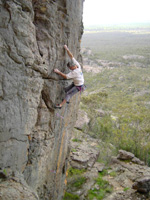
HB: I donít know if Iíd have one crag that Iíd put above all else. I guess
I have a number of crags that I guess I would consider fairly equal. One
is obviously Taipan. Which in some respects probably has the highest
quality routes on it and some of the most unique climbing. But then there
are other places like Muline [in the Grampians, Victoria Range] which is
excellent. The area where Iíve been climbing recently has some fantastic
routes, up in the Victoria Range. And Buffalo. So I guess between Buffalo
and the Grampians. I like Arapiles less so these days because I think Iíve
climbed too much there in the past and I find a lot of the climbing quite
slick, polished, certainly on some of the harder routes. But then when I
think about other places I like in Australia, I mean Frog Buttress [in
QLD] is just excellent. Itís got so many good routes and itís the perfect
place to go mid-winter, so Iíd count that as a really good crag to go to
as well. And then I think about Tasmania, thereís some good places to
climb in Tasmania. But yeah I guess pretty much Grampians and Buffalo
would be my two favourite places to climb in Australia.
Above Right: Malcolm
Matheson onsights Raindancer (21),
Cut Lunch Walls,
Grampians. Photo By Neil Monteith.
Others: What about in NSW?
HB: Iíve climbed in NSW, and yeah the climbing is good, but I donít think
Iíve climbed anything in NSW that would be as favourite to me as the
Grampians and Buffalo. And The Grampians and Buffalo are very different
styles of climbing. They mean different things to me.
Chockstone: Have you got any unfinished
projects that youíre working on and coming back too?
HB: Oh... Iíve got unfinished projects, but I wouldnít say Iím working on
them at the moment. I mean, Gilgamesh (31 M0) being one of them.
[chuckles].
Chockstone: Which you havenít looked at
in 10 years.
HB: Exactly. Thereís a project at Buffalo which I havenít done, that Iíd
like to do at some point. And thereís other new routes which I havenít
even started preparing that Iíve got in mind in the Grampians. Yeah, Iím
certainly still pretty keen to do some new routes in the Grampians. But
yeah I donít actually have a project as such that Iím currently working
on. Oh, I guess I did recently until two weekends ago when I did this
Space Odyssey route.
Chockstone: Now I have to ask what ďHBĒ
stands for? Iíve been told a couple of things but whatís the story?
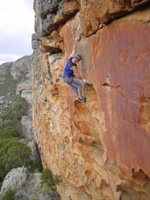 HB: Yeah Iíve been told a couple of things too. [laughs]. You ever heard
of the Monty Python skit called ďLife Of BrianĒ or something? Where
everybody referred to each other as ďBruceĒ? That was popular around the
campfire in 1980 or close to when I first started climbing and so people
were referring to each other as ďBruceĒ. You would have ďAdelaide BruceĒ
and youíd have ďMelbourne BruceĒ and youíd have ďHorsham BruceĒ. [laughs].
Which is where the origins of it came from.
HB: Yeah Iíve been told a couple of things too. [laughs]. You ever heard
of the Monty Python skit called ďLife Of BrianĒ or something? Where
everybody referred to each other as ďBruceĒ? That was popular around the
campfire in 1980 or close to when I first started climbing and so people
were referring to each other as ďBruceĒ. You would have ďAdelaide BruceĒ
and youíd have ďMelbourne BruceĒ and youíd have ďHorsham BruceĒ. [laughs].
Which is where the origins of it came from.
Right: Malcolm Matheson
nails the crux throw on The Big Payback (25),
Cut Lunch Walls,
Grampians. Photo By Neil Monteith.
Chockstone: Okay, what about the future.
Do you see yourself climbing well into the future?
HB: I think if my interest is still there, for sure. I canít see any
reason not to, if Iím still interested. I sometimes wonder why I am still
enthusiastic after 25 years because I know people I started climbing with
no longer climb or very rarely do. I sort of wonder why, at times, I am
still so interested. But it has been a very important part of my life and
Iíve gotten a hell of a lot from it. I think one of my long term goals is
to still be able to do Monkey puzzle when Iím 60, which would be good.
[chuckles].
Chockstone: Most people would just love
to do it once.
HB: I donít know if Iíll still be climbing in another 18 years, but then
who knows? I might get into Wind Surfing or something like that. [laughs].
Chockstone: Or take up Golf?
HB: Nar, golfís a bit slow. [laughs].
 |
*
Malcolm Matheson cruising up the Scoop Rocks sport route Poison Bait (25) in the Grampians' Victoria Range. Fully horizontal across the powerful, endurance roof moves, HB locks off with one arm and conducts a lengthy conversation (edited out) with those below like he'd bumped into an old friend while in town. Footage shot from a nearby tor is steady and presents well up until the contrasty sky plays backdrop to the final moves. Video By Michael Boniwell. |
 |
Malcolm Matheson on The Big Pay Back (25), Cut Lunch Walls, Grampians. Camera work a little unsteady, but undeniably HB doing what he does best, on steep power moves. Video By James Pfrunder. |
Further Reading:
![]()
Rock Magazine - Issue 44. A very good profile
of Malcolm as at December 2000.
Home | Guide | Gallery | Tech Tips | Articles | Reviews | Dictionary | Forum | Links | About | Search
Chockstone Photography | Landscape Photography Australia | Australian Landscape Photography
Please read the full disclaimer before using any information contained on these pages.
All text, images and video on this site are copyright. Unauthorised use is strictly prohibited.
